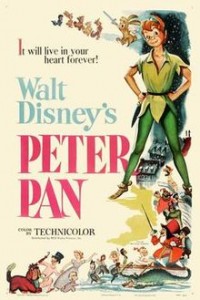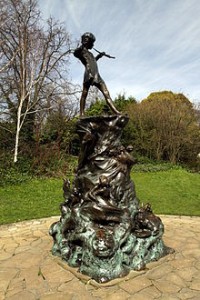Peter Pan ***** (1953, Walt Disney) – Classic Movie Review 1416
Supervising directors Hamilton Luske, Clyde Geronimi and Wilfred Jackson’s 1953 classic animated feature film based on Scottish novelist and playwright Sir James M Barrie’s play Peter Pan, or The Boy Who Wouldn’t Grow Up is one of the Walt Disney studio’s very best. In Barrie’s famous story, the mischievous boy who can fly and never grows up flies off to Never Never Land and fights pirates.
It begins at the beginning of the 20th century in Edwardian London in the neighbourhood of Bloomsbury, where as Wendy Darling delights her brothers with the wonder of bedtime stories, telling them about the mythical Peter Pan, the boy who spends his never-ending childhood adventuring on the small island of Neverland as the leader of his gang, the Lost Boys, interacting with mermaids, Native Americans, fairies, pirates and occasionally ordinary children from the world outside of Neverland.
Disney’s Peter Pan is lit up by its delightfully drawn characters (Peter, pirate chief Captain Hook, the crocodile and the non-speaking Tinkerbell), cute tunes by Sammy Cahn and Sammy Fain and others (‘You Can Fly!’, ‘What Made the Red Man Red?’ ‘Following the Leader’, ‘The Second Star to the Right’, ‘Never Smile at a Crocodile’, ‘The Elegant Captain Hook’ ”Your Mother and Mine’ and ‘A Pirate’s Life’), and the confident handling of the beloved children’s story.
‘Never Smile at a Crocodile’ – Words by Jack Lawrence; music by Frank Churchill. ‘Following the Leader’ – Words by Winston Hibler and Ted Sears. ‘A Pirate’s Life’ – Words by Ed Penner; music by Oliver Wallace; vocals by The Mellomen. ‘What Made the Red Man Red?’ became controversial because of its stereotypes of Native Americans.
Naturally it isn’t perfect and there are inevitably a few small niggles. American child star Bobby Driscoll isn’t everybody’s idea of the voice of Peter Pan nor American character actor Hans Conried as the voices of George Darling and pirate Captain Hook either. And there’s too much emphasis on the sentimental side in the nursery scenes and on the American-style comic relief wackiness of the villains. But, nevertheless, niggles aside, it’s still a lovely, magical, memorable movie. And London-born Kathryn Beaumont is ideal as the voice of Wendy though.
It is the 14th film in the Walt Disney Animated Classics series and was originally released on February 5 1953 by RKO Pictures, their last one before Disney’s founding of his own distribution company, Buena Vista Distribution, later in 1953. It is the second Disney animation with Beaumont, Heather Angel (as Mary Darling) and Bill Thompson (as Mr Smee, Hook’s assistant) after their vocal roles Alice in Wonderland. It is the final film in which all nine members of Disney’s so-called ‘Nine Old Men’ worked together as directing animators. Disney entered the film into the 1953 Cannes Film Festival.
Walt Disney personally cast Beaumont as Alice and Wendy after seeing the film On an Island with You, in which the child actress had a small role. Michael Jackson said Peter Pan was his favourite movie, using the name Neverland Ranch for his estate in Santa Barbara, where he had a private amusement park.
It is loosely remade in live action by Steven Spielberg as Hook in 1991 and again as Peter Pan in 2003. Sequel: Return to Never Land (2002).
A series of direct-to-DVD prequels produced by DisneyToon Studios focusing on Tinker Bell began in 2008, with Tinker Bell and the Pirate Fairy released in UK cinemas in 2014. Johnny Depp plays Barrie in the 2004 biopic Finding Neverland.
http://derekwinnert.com/peter-pan-classic-film-review-789/
http://derekwinnert.com/tinker-bell-and-the-pirate-fairy-film-review/
http://derekwinnert.com/finding-neverland-classic-film-review-124/
© Derek Winnert 2014 Classic Movie Review 1416
Check out more reviews on http://derekwinnert.com/














